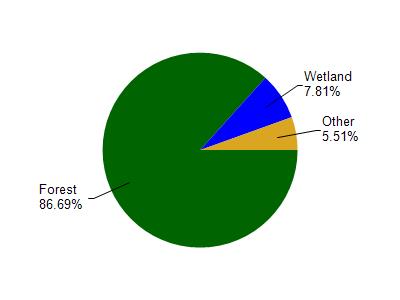
10.11 Miles
0 - 10.11
Macroinvertebrate, Coldwater
2020
Good
Bayfield
Yes
Yes
No
Fish and Aquatic Life
Overview
The Cranberry River, which drains about 27 square miles, forms a lagoon area where it meets lake Superior. The lower reach of the river forms a coastal wetland. The lagoon and lower reach support a varied fishery of warm water species and trout and salmon. Shiners and northern pike use the area for spawning. The Cranberry River is an important stream for fish as it is used for spawning by resident brook trout and by migratory brown and rainbow trout and coho salmon. This area is considered by the Lake Superior Binational Program important to the integrity of the Lake Superior ecosystem for coastal wetlands, vital functions for planning objectives and fish and wildlife spawning and nursery grounds. The Cranberry River is part of the state South Shore Fish and Wildlife Area. The mouth is bordered by land in state ownership and by the village of Herbster. Farther upstream, the river flows primarily through state-owned land.
South of the state fishery lie the headwaters and Asprings@ that feed the Cranberry River. This area is county forest land and lies some distance from Lake Superior. To maintain ecosystem integrity, it's important to eliminate threats to such headwater areas. While the headwaters lie in county-owned land, a section of the river below the headwaters and above the state fishery area (which extends some three miles upriver from the lake) flows through private land. Migratory fowl use the area. The Cranberry River has been classified as an outstanding resource water.
From: Turville-Heitz, Meg. 1999. Lake Superior Basin Water Quality Management Plan. Wisconsin Department of Natural Resources, Madison, WI.
Date 1999
Author Aquatic Biologist
Condition
Wisconsin has over 84,000 miles of streams, 15,000 lakes and milllions of acres of wetlands. Assessing the condition of this vast amount of water is challenging. The state's water monitoring program uses a media-based, cross-program approach to analyze water condition. An updated monitoring strategy (2015-2020) is now available. Compliance with Clean Water Act fishable, swimmable standards are located in the Executive Summary of Water Condition in 2018. See also the 'monitoring and projects' tab.
Reports
Management Goals
Wisconsin's Water Quality Standards provide qualitative and quantitative goals for waters that are protective of Fishable, Swimmable conditions [Learn more]. Waters that do not meet water quality standards are considered impaired and restoration actions are planned and carried out until the water is once again fishable and swimmable
Management goals can include creation or implementation of a Total Maximum Daily Load analysis, a Nine Key Element Plan, or other restoration work, education and outreach and more. If specific recommendations exist for this water, they will be displayed below online.
Monitoring
Monitoring the condition of a river, stream, or lake includes gathering physical, chemical, biological, and habitat data. Comprehensive studies often gather all these parameters in great detail, while lighter assessment events will involve sampling physical, chemical and biological data such as macroinvertebrates. Aquatic macroinvertebrates and fish communities integrate watershed or catchment condition, providing great insight into overall ecosystem health. Chemical and habitat parameters tell researchers more about human induced problems including contaminated runoff, point source dischargers, or habitat issues that foster or limit the potential of aquatic communities to thrive in a given area. Wisconsin's Water Monitoring Strategy was recenty updated.
Grants and Management Projects
| Project Name (Click for Details) | Year Started |
|---|
|
|
Monitoring Projects
| WBIC | Official Waterbody Name | Station ID | Station Name | Earliest Fieldwork Date | Latest Fieldwork Date | View Station | View Data |
|---|
| 2879800 | Cranberry River | 10015393 | Cranberry River- 5 M Upstream Touve Rd- Station #2 | | | Map | Data |
| 2879800 | Cranberry River | 10051610 | Confluence at Cranberry and East Fork | | | Map | Data |
| 2879800 | Cranberry River | 10015391 | Cranberry River- 145 M Upstream Old Hwy 13- Station #1 | 5/21/2012 | 7/2/2020 | Map | Data |
| 2879800 | Cranberry River | 10051599 | Confluence at Cranberry and East Fork | | | Map | Data |
| 2879800 | Cranberry River | 10015392 | Cranberry River- Upstream 4 Wheeler Trail Off Mcinerney Rd- Station #3 | | | Map | Data |
|

Watershed Characteristics
Cranberry River is located in the Bayfield Peninsula Northwest watershed which is 236.05 mi². Land use in the watershed is primarily forest (86.60%), wetland (7.80%) and a mix of grassland (4.60%) and other uses (0.90%). This watershed has 473.06 stream miles, 43,216.55 lake acres and 6,677.27 wetland acres.
Nonpoint Source Characteristics
This watershed is ranked Not Ranked for runoff impacts on streams, Not Available for runoff impacts on lakes and Low for runoff impacts on groundwater and therefore has an overall rank of Low. This value can be used in ranking the watershed or individual waterbodies for grant funding under state and county programs.However, all waters are affected by diffuse pollutant sources regardless of initial water quality. Applications for specific runoff projects under state or county grant programs may be pursued. For more information, go to surface water program grants.
Cranberry River is considered a Macroinvertebrate, Coldwater under the state's Natural Community Determinations.
Natural communities (stream and lake natural communities) represent model results and DNR staff valiation processes that confirm or update predicted conditions based on flow and temperature modeling from historic and current landscape features and related variables. Predicated flow and temperatures for waters are associated predicated fish assemblages (communities). Biologists evaluate the model results against current survey data to determine if the modeled results are corect and whether biological indicators show water quaity degradation. This analysis is a core component of the state's resource management framework. Wisconsin's Riverine Natural Communities.